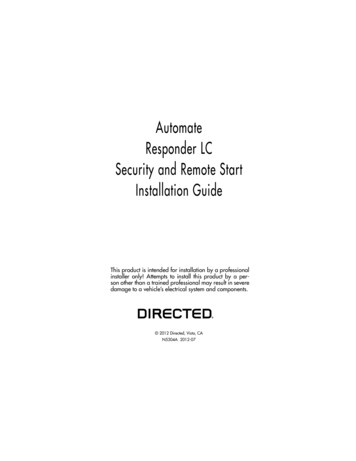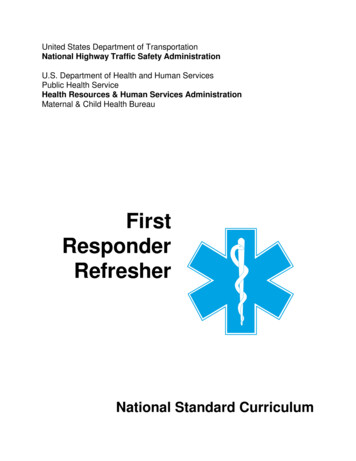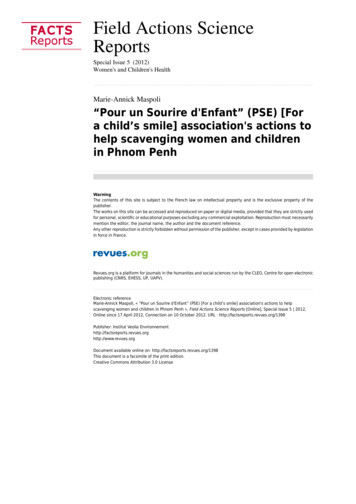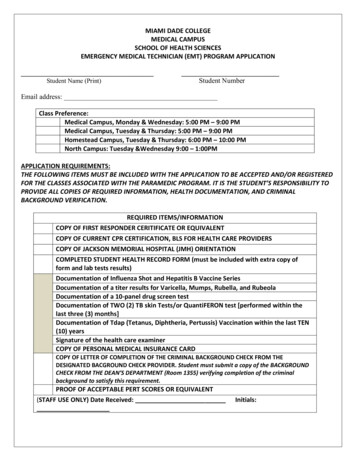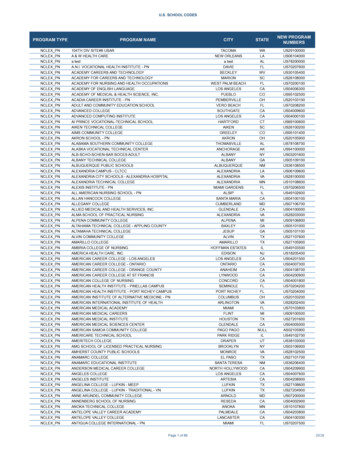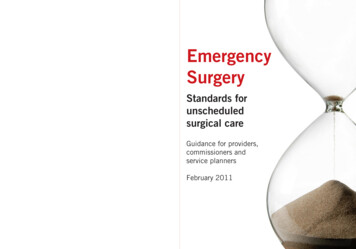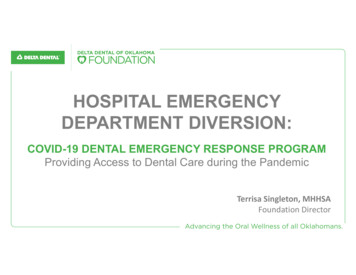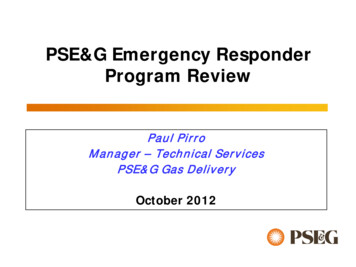
Transcription
PSE&G Emergency ResponderProgram ReviewPaul PirroM anager – Technical ServicesPSE& G Gas DeliveryOctober 2012
PSE&G Background 1.8 Million CustomersGas Delivery maintains2000 EmployeesService Territory:2,400 square miles in17 Counties40% Urban/60% Rural61 miles oftransmission pipeline17,600 miles ofdistribution main17,000 miles ofservices
PSE&G Background 750 ServiceTechnicians serve 12District areasResponsibilities: Utility Service Work(Tariff) Appliance Repair HVAC InstallationsApprox. 100,000 Leak &Emergency calls peryearFully AutomatedDispatching System
Federal Regulations forEmergency Response PHMSA (DOT) 49 CFR (Code of FederalRegulations) Sections: 192.605 & 192.615 Operator emergency plans must includeprovisions for coordinating preplanned drills andresponse to actual pipeline emergencies withfire, police and other public officials 192.616 Operators must develop and implement a writtencontinuing education program 192.615 & 192.616 Operators must perform “Outreach” as requiredunder Emergency Plans and Public EducationPrograms
NJ Emergency Response Program New Jersey maintains 576 Fire Stations(paid/volunteer) that serve 566 municipalities.Over the years, NJ has maintained a proactiveposition by ensuring that Emergency Responders aretrained and well prepared to handle all types ofemergencies.The NJ Administrative Code (NJAC) requires utilitiesto offer training and establish liaison with FD’s, OEM’sand Public Officials for handling gas pipelineemergencies.According to the NJAC, energy providers areexpected to conduct an annual drill covering atransmission pipeline emergency.
NJ Emergency Response Program Utility Hazard Awareness Program was developed by a statewide team in 2008: NJ Utility Representatives Propane Representative AEGIS Loss Prevention Services State Fire MarshallsProgram was designed to provide emergency responseofficers with utility hazard awareness and safety aspects forintegration into SOP’s for a coordinated approach toincidents. Fire, Police, EMT & OEM groups
NJ Emergency Response Program Program Objective: Provide information about utility hazards andsafety considerations for emergency responders. Provide opportunity for different emergencyagencies to discuss their emergency responseSOP’s and coordination prior to an event. Aid in development and enhancement of SOP’s. Recommend an approach consistent with NationalIncident Management System (NIMS) forcoordination with utilities and facility owners.
Subject Areas Covered Utility First ResponseDurham WoodsTransmission PipelineExplosion (Edison, NJ)Gas DeliveryInfrastructureMetering & RegulatingStationsProperties of Natural Gas
Subject Areas Covered Natural Gas ExplosiveRangeGas Detector CalibrationLiquid PropaneNatural Gas Storage(LNG)*LNG Truck & TrailerEmergency Response** Added since San BrunoIncident
Subject Areas Covered Utility Leak & EmergencyResponse ProcessNatural Gas Do’s & Don’tsMeter Valve Shut-offDiagramGas Migration ReviewWeather RelatedChallenges (Ground Frost,Flooding, Ice, Snow)
Subject Areas Covered Carbon Monoxide ReviewGas Mandated ProgramsPipeline MarkoutsNJ Gas DamageSummaryGas Industry Websites
Supplemental Video Program AEGIS “Natural Gas Recognizing and Avoiding theHazards” Video Training Tool for EmergencyResponders (Volumes 1 and 2).Provides an effective review of the gas deliverysystem, properties of natural gas, and safe practicesfor dealing with emergencies involving natural gasleaks, fires, and carbon monoxide.Available for display or purchase at:www.aegislink.com
AEGIS Video Segments & Actions- Volumes 1 & 2 Properties of NGNG Delivery SystemKeeping System SafeWhen Gas Escapes fromSystemDetection of NGNG Fires – OutsideCNG VehicleEmergencies Gas Burning InsideCarbon MonoxideNG EmergencyPreparednessStatic ElectricityIndustrial FiresGas Main Leaks & FiresOdorant EmergenciesLNG
Utility Safety Program ResourcesFIREFIGHTER’S HANDBOOK – Addendum NEW JERSEY EDITION by Delmar Leaning(Fire Fighter I training program - 2006)Section D Public Utilities, Propane and Carbon Monoxide HazardsResponding to Utility Emergencies – Michael Callan, Red Hat Publishing Companywww.redhatpub.comNew Jersey One-Call – Damage Prevention http://www.nj1-call.org/whats new.phpFEMA – Developing Effective Standard Operating Procedures – For Fire and -197.pdfNational Institute for Occupational Safety and Health, CDC azards.com/safety ine Emergencies – Gregory G, Noll & Michael S. Hildebraandwww.pipelineemergencies.comChemical Safety Board (CSB) - http://www.chemsafety.govNational Transportation Safety Board (NTSB) - http://www.ntsb.gov
Natural Gas Safety Resources Elizabethtown GasNew Jersey Natural GasPublic Service Electric and GasSouth Jersey mwww.sjindustries.comNew Jersey One Call Centerwww.nj1-call.orgNew Jersey Board of Public Utilities www.bpu.state.nj.usNortheast Gas Associationwww.northeastgas.orgAmerican Gas Associationwww.aga.orgCommon Ground Alliancewww.commongroundalliance.comNew Jersey Common Ground Alliance www.njcga.orgPHMSA Pipeline Safety Programwww.phmsa.dot.govPipeline Emergencieswww.pipeline.mindgrabmedia.co
Development ofEmergency Response Plans An “AGA Engineering Technical Note”, dated12/15/11, provides guidance to natural gas servicecompanies for developing their emergency responseplans.This document includes: Agency Recommendations & Advisories from pastIncident Investigations Key Issues for structuring a UtilityCommunications Plan Comprehensive Emergency Response Checklist Resources for Safety Communications
Mutual Aid Plans Include plans to request manpower and equipment resources toassist in gas repair and restoration activities Industry (AGA) Regional (NGA) Local (State)The AGA website provides immediate access to a MutualAssistance Program and Emergency Planning Resource CenterThis AGA Mutual Aid Database provides the ability to search forgas utilities and product & service providers.AGA website gmarc/Pages/default.aspx
Damage Prevention Overall, gas pipelinedamages are decliningannually.No one area of focus isattributed to thispositive trend.We find that pipelineoperators need to domany things to promotethis continuousimprovement.
Damage Prevention Explosions can occur,regardless of pipe sizeand pressure.Most damageincidents have beeninvolved with servicepipe on customerproperty.
Police Awareness for Markouts We ask Police to reportoccurrences when they findstreet construction areasthat are not marked out.We make it clear that thisaction will help thecommunity by preventingdamages, which will, inturn, eliminate additionaltrips by emergencyresponders.
Critical Gas Levels - UEL & LELComparison of gas detection readings % gas vs. % LELPercent gas in airPercent LELNatural gas will not igniteabove the UEL-too richUpper Explosive Limitof Natural Gas (UEL)15%14%Note: All detectionequipment needs to bePROPERLY USED,MAINTAINED, ANDCALIBRATED.13%12%11%Natural Gas15 %Upper Explosive Limit UEL5%Upper Explosive Limit UEL10%Flammable range ofnatural gas.(5%-15%)9%Lower Explosive Limit LFL8%7%6%5%4%3%2%1%% gas100%Natural gas will not ignitebelow the LEL-too lean-80%Lower Explosive Limitof Natural Gas (LEL)Note: 1% gas in air isequal to 10,000 PPM60%40%20%% LELAny open air readingabove 1% or 20% of theLEL - immediatelyevacuate the building ofall personnel includingemergency responders If a gas concentration is above15%, animminent danger existsLower Explosive Limit LELwhen venting. As gas dissipates, it will passthrough the Explosive Rangebefore reaching 0%.
CGI Calibration for AccuracyCombustible Gas Indicators (CGI) must becalibrated according to manufacturerspecifications. The CGI is calibrated using a specific gas. If any gas other thanmethane is used, CGI sensitivity and response may not directlycorrespond to the actual natural gas level being measured. CGI readings are only accurate for the type of gas used to calibrate theCGI. Adjustments to readings need to be made for all other gases toobtain the actual flammable level. Some CGI manufacturers provide a table with correction factors usedto obtain a more accurate reading if the gas being tested is not the gasused to calibrate the CGI.
Gas Leak Detection Equipment During FD training, PSE&Greviews the need tocalibrate gas detectionequipment periodically.Bascom-Turner Gas SentryCGI’s equipped for CH4and CO are used by over750 service technicians(first responders).Instruments at PSE&G areautomatically calibrated ina docking station andtracked on a monthlybasis.
Gas Leak Detection Equipment PSE&G will allow accessto automatic calibrationequipment for any FDthat purchases BascomTurner gas detectioninstruments.For periodiccalibrations, PSE&G willallow access to anyassigned Gas Districtlocations during normalbusiness hours.
Park Upwind of Blowing Gas
Gas Leak MigrationGas leakpresent athouse 516Possiblemigration atallneighboringhouses
Gas Migration Considerations Use full personal protective equipment Always assume there are multiple gas leaks – you must verify thatthe area is clear of gas. Check entire area, including across the street,surrounding buildings & subsurface structures. Use properly calibrated gas detection equipment Ground conditions can impact gas migration and leak pattern Always coordinate actions with the utility Follow action levels, communication, & gas readings Once gas is controlled and sources of ignition eliminated, use care inairing out buildings (may bring into explosive range) Some gas service lines have excess flow valves (EFV’s) for protection
Natural Gas Do’s & Don’tsDo: Notify the gas company immediately while enroute - utilizethe gas company’s expertise Treat all gas leaks as potentially hazardous When in doubt, evacuate structures and/or surroundings Look for multiple gas leaks even if the gas is burning Secure affected areas by doing a complete hazard assessmentof area Use only properly calibrated leak detection equipment – CGImust be turned on in a non-gaseous environment Establish detection equipment action levels (evacuationthresholds) Use only intrinsically safe communication devices and otherelectrically operated equipment Only shut off above-ground meter valves
Natural Gas Do’s & Don’tsDon’t: Park over manhole or valve covers, storm drains or tooclose to structures Park in front or downwind of emergency locations Use open flames (flares, smoking, other sources) Operate any in-ground or underground valves Operate doorbells, light switches, other electrical devicesor ignition sources (pagers, cell phones, radios) Turn off venting relief valves Extinguish gas fires until fuel sources have been secured Turn on gas valves Shut off gas service to industrial facilities withoutknowledge of its effect - this can cause additional damage
Meter Valve Shut-offsNever force anabove groundgas meter valvein the wrongdirection!Valve in on positionMatch the wings!Valve in off position
Carbon Monoxide (CO)Carbon Monoxide is a product of“Incomplete Combustion”.CH4 2O2 CO2 2H2O(v)Consider the chemical formula for CompleteCombustion. Carbon Monoxide (CO) isformed when not enough air (O2) is availableto create carbon dioxide (CO2).1 cu.ft.gas 2 cu.ft.air 1 cu.ft.carbondioxide 2 cu.ft.water vapor
CO Characteristics ColorlessOdorlessTastelessNonirritating Invisible tohumans Lighter than airHighly Toxic in VerySmall ConcentrationsExplosive Range 12% to 74% “Backdraft”experienced byfirefighters
CO Warning SignsNoticeable Conditions: Aldehydes – an alcoholodor may accompany CO inthe processCondensation – may bevisible on walls or windowsin affected areaDead Houseplants – dueto absence of oxygenLethargic Pets – smallpets “get tired” quicklyfrom effects of CO, due toa higher breathing rate.
Carboxyhemoglobin (COHb) “Carboxyhemoglobin” is the poisoning of theblood due to effects from carbon monoxide (CO)In the process, CO is transferred to blood via lungsCO bonds with hemoglobin in bloodCO reduces blood’s ability to transport O2throughout the bodyCO is 200x more attracted to blood hemoglobin thanO2To reverse effects from CO poisoning, need 200parts O2 to replace one part CO
Progressive Flu-Like Symptoms Low/MediumExposure Symptoms: Headache Dizziness Fatigue Nausea Poor Coordination Confusion High ExposureSymptoms: Severe Headache Shortness ofBreath Chest Pains Vomiting Red Eyes Unconsciousness Coma Death
Increased Susceptibility to CO Pregnant Mothers – fetusexperiences effects beforethe motherInfants – due to higherrespiration rateHeart Condition Cases –the heart is the first majororgan to be affectedSmokers – some CO mayalready be in blood prior to asignificant exposure
1 HOUR EXPOSURE LIMITS& SYMPTOMS 200 ppm (15%) slight headache400 ppm (30%) headache drowsiness nausea600 ppm (45%) coma brain damage
Treatment for CO Poisoning Breathing Fresh AirHigh Flow Oxygen –administered on site byemergency responders(EMS)Hyperbaric Chamber –administered in hospitals
Emergency Responder TrainingImplementation PSE&G uses supervisors fromoperations and support areas whoare experienced and receivedEmergency Response Training.Supervisors from 4 operating areasare designated to provide trainingto emergency responders in theservice territory.PSE&G sends annual traininginvitations to Fire Chiefs, Mayors,Business Administrators & Officesof Emergency Management.Municipal representatives areinvited every 2 years.
Emergency Responder TrainingImplementation PSE&G provides attendees with packages containingpresentations slides, damage prevention brochures,“What You Need To Know About Safety” info andCD’s with supporting resources and trainingmaterials.PSE&G tracks training participants with a sign-insheet, and a dated attendance list is prepared forfuture use.PSE&G hand delivers presentation material packagesto FD’s and municipalities that were not inattendance.
Reference Material Package Utility Hazard Awareness Program – ParticipantManual & Instructor GuideState Maps – Gas & Electric Utility Service AreasEmergency Response Guidebook for HazardousMaterialsMSDS for Natural GasCPSC CO Response GuidePropane - Hazard Info & Small Cylinder SafetyCase Studies: NTSB – National Transportation Safety Board CSB – Chemical Safety Board (Propane) NASFM – National Association of State FireMarshalls BLEVE (Boiling Liquid Expanding Vapor Explosion)
Emergency Responder TrainingImplementation PSE&G normally provides training to a collection ofemergency response groups assembled at a Companyfacility.If requested, PSE&G will also provide the same trainingat FD and municipal locations.Attendance is monitored very closely, and every effortis made to achieve full participation from all emergencyresponse groups.
Municipal Drills & Meetings Since the San Bruno (CA) incident, Municipalities andFire Departments have become much moreresponsive to meeting with gas operators to discussemergency response.Various municipalities may invite PSE&G toparticipate in local discussions or tabletop drills toaddress how utilities would respond to various typesof incidents.Recent tabletop drills with the State focused onresponse to damage caused by potential naturaldisasters or terrorist activities.
NJ Transmission PipelineOperator Requirements Due to PHMSA (DOT) & NJ Administrative Coderequirements, Utilities & Emergency Responders in NJhave been well prepared to handle gas transmissionfacility incidents.Each public utility operator is required to meet on anannual basis with appropriate fire, police, and otherpublic officials of each municipality through which itstransmission pipeline traverses.Operators are required to maintain records ofoutreach meetings with local officials, includingattendance and the basic topics covered.
Transmission OperatorOutreach Meetings To meet NJAC requirements and DOT (PHMSA) CodeRule 192.615, the PSE&G Pipeline Integrity Managerconducts face-to-face meetings with fire, police, andpublic officials from each municipality having gastransmission pipelines in their jurisdictional area.The group reviews facility maps, recent system changesand critical valve locations for emergency shutdown.PSE&G shares copies of transmission pipeline maps withtop emergency response officials.PSE&G ensures that each emergency response groupunderstands the hazards when responding to a gastransmission pipeline incident.
FOR MORE INFORMATION Paul Pirro Manager - TechnicalServices PSE&G Gas Delivery 24 Brown AvenueSpringfield, NJ 07081973-912-3239 paul.pirro@pseg.com
PSE&G Background 1.8 Million Customers Gas Delivery maintains 2000 Employees Service Territo
